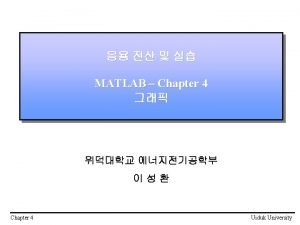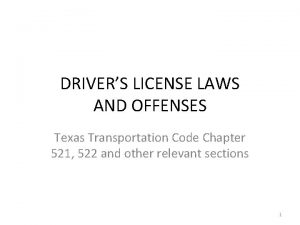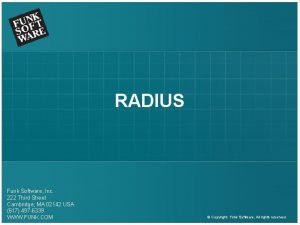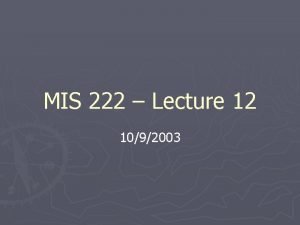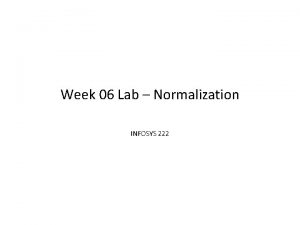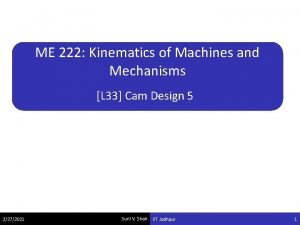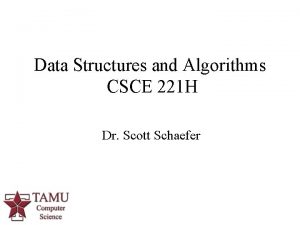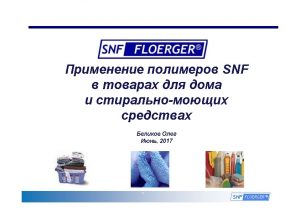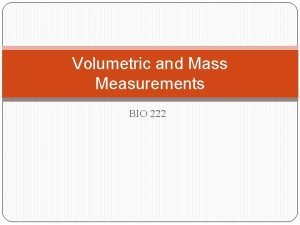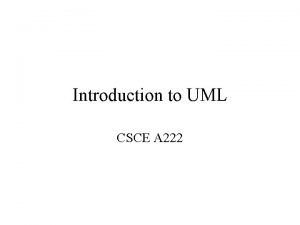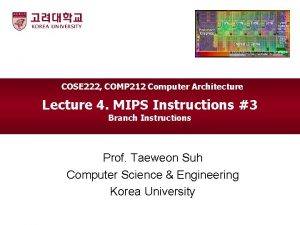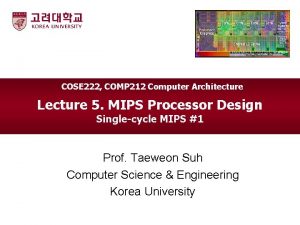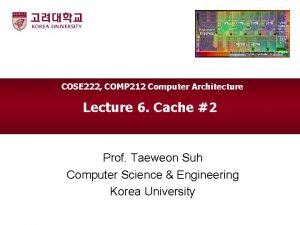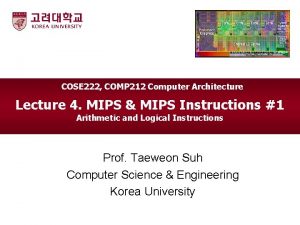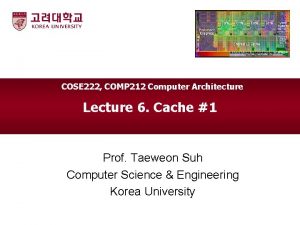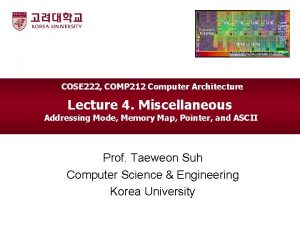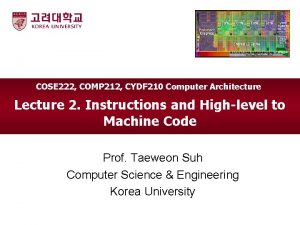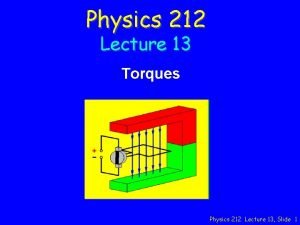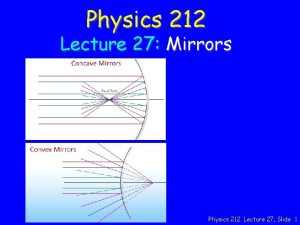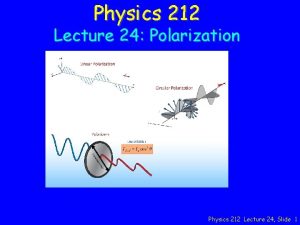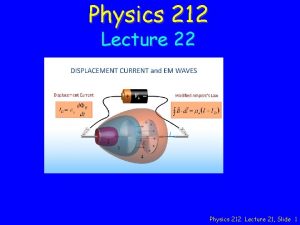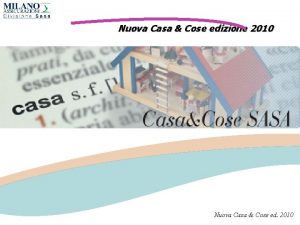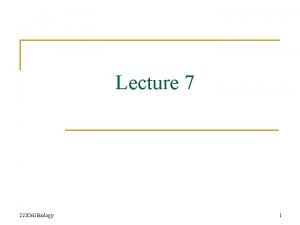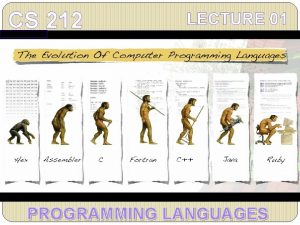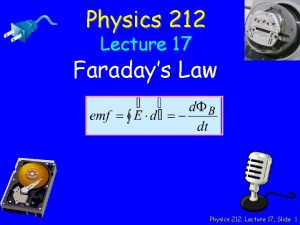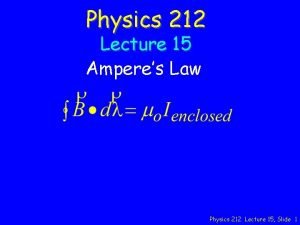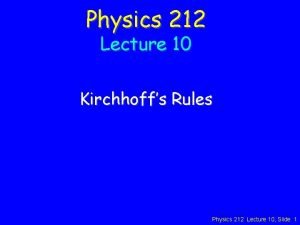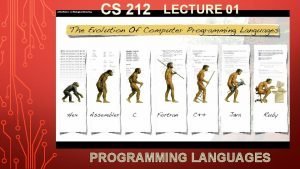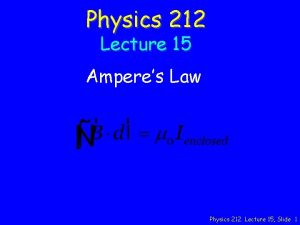COSE 222 COMP 212 Computer Architecture Lecture 5














![Verilog Code – ALU module alu(input [31: 0] a, b, input [2: 0] alucont, Verilog Code – ALU module alu(input [31: 0] a, b, input [2: 0] alucont,](https://slidetodoc.com/presentation_image_h/268c50ee72a17a0f36690e231c899de0/image-15.jpg)








![Verilog Code - Main Decoder and ALU Control module maindec(input [5: 0] op, output Verilog Code - Main Decoder and ALU Control module maindec(input [5: 0] op, output](https://slidetodoc.com/presentation_image_h/268c50ee72a17a0f36690e231c899de0/image-24.jpg)






- Slides: 30

COSE 222, COMP 212 Computer Architecture Lecture 5. MIPS Processor Design Single-Cycle MIPS #2 Prof. Taeweon Suh Computer Science & Engineering Korea University

Single-Cycle MIPS • Again, keep in mind that microarchitecture is composed of 2 interacting parts § Datapath § Control • Let’s execute some example instructions on what we have designed so far • Then, we are going to design control logic in detail 2 Korea Univ

Single-Cycle MIPS - lw • Let’s start with a memory access instruction - lw lw $2, 80($0) • STEP 1: Instruction Fetch 3 Korea Univ

Single-Cycle MIPS - lw • STEP 2: Decoding § Read source operands from register file lw $2, 80($0) 4 Korea Univ

Single-Cycle MIPS - lw • STEP 2: Decoding § Sign-extend the immediate lw $2, 80($0) module signext(input [15: 0] a, output [31: 0] y); assign y = {{16{a[15]}}, a}; endmodule 5 Korea Univ

Single-Cycle MIPS - lw • STEP 3: Execution § Compute the memory address lw $2, 80($0) 6 Korea Univ

Single-Cycle MIPS - lw • STEP 4: Execution § Read data from memory and write it to register file lw $2, 80($0) 7 Korea Univ

Single-Cycle MIPS – PC • CPU starts fetching the next instruction from PC+4 module adder(input [31: 0] a, b, output [31: 0] y); assign y = a + b; endmodule adder 8 pcadd 1(. a (pc), . b (32'b 100). y (pcplus 4)); Korea Univ

Single-Cycle MIPS - sw • Let’s execute another memory access instruction - sw § sw instruction needs to write data to memory Example: sw $2, 84($0) 9 Korea Univ

Single-Cycle MIPS - add, sub, and, or • Let’s consider arithmetic and logical instructions - add, sub, and, or § Write ALUResult to register file § Note that R-type instructions write to rd field of instruction (instead of rt) 10 Korea Univ

Single-Cycle MIPS - beq • Let’s consider a branch instruction - beq § Determine whether register values are equal § Calculate branch target address (BTA) from sign-extended immediate and PC+4 Example: beq $4, $0, around 11 Korea Univ

Single-Cycle MIPS - or • Let’s see how or instruction works out in the implementation with control signals 12 Korea Univ

Single-Cycle MIPS • As mentioned, CPU is designed with datapath and control • Now, let’s delve into the ALU and control part design 13 Korea Univ

ALU (Arithmetic Logic Unit) adder N = 32 in 32 -bit processor F 2: 0 Function 000 A&B 001 A|B 010 A+B 011 not used 100 A & ~B 101 A | ~B 110 A-B 111 SLTU // sltu (set less than unsigned) // $t 0 = 1 if $t 1 < $t 2 sltu $t 0, $t 1, $t 2 14 Korea Univ
![Verilog Code ALU module aluinput 31 0 a b input 2 0 alucont Verilog Code – ALU module alu(input [31: 0] a, b, input [2: 0] alucont,](https://slidetodoc.com/presentation_image_h/268c50ee72a17a0f36690e231c899de0/image-15.jpg)
Verilog Code – ALU module alu(input [31: 0] a, b, input [2: 0] alucont, output reg [31: 0] result, output zero); wire [31: 0] b 2; wure sltu; wire [32: 0] sum; assign b 2 = alucont[2] ? ~b: b; // addition (sub) assign sum[32: 0] = a + b 2 + alucont[2]; assign sltu = ~sum[32]; // for SLTU always@(*) begin case(alucont[1: 0]) 2'b 00: result <= 2'b 01: result <= 2'b 10: result <= 2'b 11: result <= endcase end a & b 2; // A & B a | b 2; // A | B sum[31: 0]; // A + B, A - B {31'b 0, sltu}; // SLTU F 2: 0 Function 000 A&B 001 A|B 010 A+B 011 not used 100 A & ~B 101 A | ~B 110 A-B 111 SLTU // for branch assign zero = (result == 32'b 0); endmodule 15 Korea Univ

Control Unit Opcode and funct fields come from the fetched instruction 16 Korea Univ

Control Unit - ALU Control • Implementation is completely dependent on hardware designers • But, the designers should make sure the implementation is reasonable enough • • ALUOp 1: 0 Memory access instructions (lw, sw) need to use ALU to calculate memory target address (addition) Branch instructions (beq, bne) need to use ALU for the equality check (subtraction) ALUOp 1: 0 Funct Meaning 00 Add 01 Subtract 10 Look at Funct 11 Not Used ALUControl 2: 0 00 X 010 (add) X 110 (subtract) 1 X 100000 (add) 010 (add) 1 X 100010 (sub) 110 (subtract) 1 X 100100 (and) 000 (and) 1 X 100101 (or) 001 (or) 1 X 101011(sltu) 111 (sltu) Truth table of “ALU Decoder “ 17 Korea Univ

Control Unit - Main Decoder Instruction Op 5: 0 Reg. Write Reg. Dst Alu. Src Branch Mem. Write Memto. Reg ALUOp 1: 0 R-type 000000 1 1 0 0 10 lw 100011 0 0 101011 1 0 1 1 X 00 00 beq 000100 0 0 X X 1 sw 1 0 0 1 0 X 01 ALUOp 1: 0 Meaning 00 Add 01 Subtract 10 Look at Funct field 11 Not Used 18 Korea Univ

How about Other Instructions? • Now, we are done with the control part design • Let’s examine if the design is able to execute other instructions Example: addi $t 0, $t 1, -14 19 Korea Univ

Control Unit - Main Decoder Instruction Op 5: 0 Reg. Write Reg. Dst Alu. Src Branch Mem. Write Memto. Reg ALUOp 1: 0 R-type 000000 1 1 0 0 10 lw 100011 1 0 0 1 00 sw 101011 0 X 1 0 1 X 00 beq 000100 0 X 0 1 0 X 01 addi 001000 1 0 0 0 00 20 Korea Univ

Control Unit - Main Decoder • How about jump instructions? § j 21 Korea Univ

Control Unit - Main Decoder • We added new hardware to support the j instruction § A logic to compute the target address § Mux and control signal 22 Korea Univ

Control Unit - Main Decoder • There should be one more output (jump) in the main decoder to support the jump instructions Instruction Op 5: 0 Reg. Write Reg. Dst Alu. Src Branch Mem. Write Memto. Reg ALUOp 1: 0 Jump R-type 000000 1 1 0 0 10 0 lw 100011 1 0 0 1 00 0 sw 101011 0 X 1 0 1 X 00 0 beq 000100 0 X 0 1 0 X 01 0 addi 001000 1 0 0 0 00 0 j 000100 0 X XX 1 23 Korea Univ
![Verilog Code Main Decoder and ALU Control module maindecinput 5 0 op output Verilog Code - Main Decoder and ALU Control module maindec(input [5: 0] op, output](https://slidetodoc.com/presentation_image_h/268c50ee72a17a0f36690e231c899de0/image-24.jpg)
Verilog Code - Main Decoder and ALU Control module maindec(input [5: 0] op, output memtoreg, memwrite, output branch, alusrc, output regdst, regwrite, output jump, output [1: 0] aluop); Meaning 00 Add 01 Subtract 10 Look at Funct 11 Not Used module aludec(input [5: 0] funct, input [1: 0] aluop, output reg [2: 0] alucontrol); reg [8: 0] controls; assign {regwrite, regdst, alusrc, branch, memwrite, memtoreg, jump, aluop} = controls; always @(*) begin case(op) 6'b 000000: 6'b 100011: 6'b 101011: 6'b 000100: 6'b 001000: 6'b 000010: default: endcase end ALUOp 1: 0 always @(*) begin case(aluop) 2'b 00: alucontrol <= 3'b 010; // add 2'b 01: alucontrol <= 3'b 110; // sub default: case(funct) // RTYPE 6'b 100000: alucontrol <= 3'b 010; // add 6'b 100010: alucontrol <= 3'b 110; // sub 6'b 100100: alucontrol <= 3'b 000; // and 6'b 100101: alucontrol <= 3'b 001; // or 6'b 101011: alucontrol <= 3'b 111; // sltu default: alucontrol <= 3'bxxx; // ? ? ? endcase end controls <= 9'b 110000010; // R-type controls <= 9'b 101001000; // lw controls <= 9'b 001010000; // sw controls <= 9'b 000100001; // beq controls <= 9'b 101000000; // addi controls <= 9'b 000000100; // j controls <= 9'bxxxxx; // ? ? ? endmodule 24 Korea Univ

Single-Cycle MIPS Performance • • How fast is the single-cycle processor? Clock cycle time (frequency) is limited by the critical path § The critical path is the path that takes the longest time § What do you think the critical path is? • The path that lw instruction goes through 25 Korea Univ

Single-Cycle MIPS Performance • Critical path of single-cycle MIPS Tc = tpcq_PC + tmem + max(t. RFread, tsext) + tmux + t. ALU + tmem + tmux + t. RFsetup • In most implementations, limiting paths are: memory (instruction and data), ALU, register file. Tc = tpcq_PC + 2 tmem + t. RFread + 2 tmux + t. ALU + t. RFsetup Elements 26 Parameter Register clock-to-Q tpcq_PC Multiplexer tmux ALU t. ALU Memory read tmem Register file read t. RFread Register file setup t. RFsetup Korea Univ

Example Elements Parameter Delay (ps) Register clock-to-Q tpcq_PC 30 Multiplexer tmux 25 ALU t. ALU 200 Memory read tmem 250 Register file read t. RFread 150 Register file setup t. RFsetup 20 Tc = tpcq_PC + 2 tmem + t. RFread + 2 tmux + t. ALU + t. RFsetup = [30 + 2(250) + 150 + 2(25) + 200 + 20] ps = 950 ps • fc = 1/Tc fc = 1/950 ps = 1. 052 GHz Assuming that the CPU should execute 100 billion instructions to run your program, what is the execution time of the program on a single-cycle MIPS processor? Execution Time = (#instructions) x (cycles/instruction) x (seconds/cycle) = (100 × 109) x (1) x (950 × 10 -12 s) = 95 seconds 27 Korea Univ

Backup Slides 28 Korea Univ

Condition Field 29 Korea Univ

ALU (Arithmetic Logic Unit) adder N = 32 in 32 -bit processor F 2: 0 Function 000 A&B 001 A|B 010 A+B 011 not used 100 A & ~B 101 A | ~B 110 A-B 111 SLTU // sltu (set less than unsigned) // $t 0 = 1 if $t 1 < $t 2 sltu $t 0, $t 1, $t 2 30 Korea Univ
 Opendns family shield
Opendns family shield Le cose importanti della vita non sono cose
Le cose importanti della vita non sono cose Architecture lecture notes
Architecture lecture notes Computer architecture lecture
Computer architecture lecture 01:640:244 lecture notes - lecture 15: plat, idah, farad
01:640:244 lecture notes - lecture 15: plat, idah, farad Bus design in computer architecture
Bus design in computer architecture Difference between computer architecture and organization
Difference between computer architecture and organization Fgi and fgo in computer architecture
Fgi and fgo in computer architecture Xxaxis matlab 222
Xxaxis matlab 222 Pineer species
Pineer species Texas transportation code 521.025
Texas transportation code 521.025 Império jogo do bicho
Império jogo do bicho Infosys 222
Infosys 222 Funk radius
Funk radius Mism-222
Mism-222 Ece 222 github
Ece 222 github Navadmin 222/15
Navadmin 222/15 Infosys 222
Infosys 222 Blk 222
Blk 222 Mide-222
Mide-222 Psalmul 6
Psalmul 6 Me 222
Me 222 Item 222
Item 222 Eco 222
Eco 222 Csce 221
Csce 221 Flosoft fs 222
Flosoft fs 222 Tentukan taksiran ke ratusan terdekat dari 599 + 222
Tentukan taksiran ke ratusan terdekat dari 599 + 222 Bio 222
Bio 222 220 rounded to the nearest ten
220 rounded to the nearest ten Psych 222
Psych 222 Tamu csce 222
Tamu csce 222








